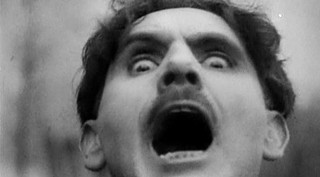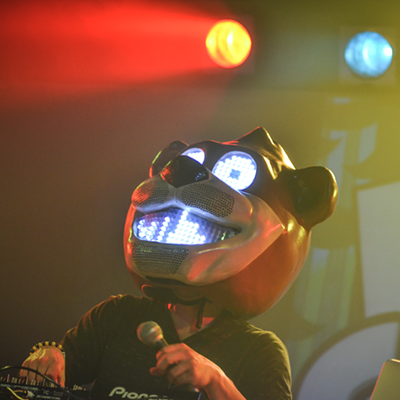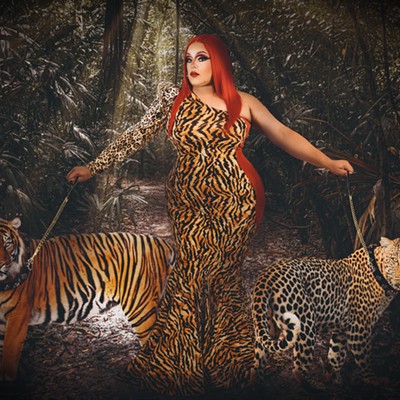With its brutal, modern, mechanized tactics, World War I devastated Europe. Everything, suddenly, was different. As people began tentative, reactionary steps towards a new kind of normalcy, so too did European artists begin thinking of things in alternative ways.
Filmmaking was still in its infancy, and inevitably it was seized upon as a new way of expressing artistic visions.
Think back to those times, Meaghan Walsh suggests: “There’s no rules. There’s nobody to look to. There are no classics. They’re doing whatever it is they want.”
Although the United States, and especially Hollywood, had already embraced film as a viable commercial medium, the Europeans – particularly the French – had different ideas. Paris was the center of this new art film movement.
“There are certainly plenty of people who are doing your typical narrative, not that exciting, or innovative films,” says Walsh. “Just telling little short stories. But you also have these people who are very experimental, getting their hands on cameras and trying to change people’s thought process.”
A self–professed “film nerd,” Walsh is the managing director of the Lucas Theatre. She’s curating Saturday’s Shadows and Light: Surrealism and the Cinematic Canvas, a screening of several short films from the 1920s, in conjunction with the Jepson Center’s Twilight Visions exhibition.
Walsh, who’s just about to finish her SCAD Master’s thesis on cinematic studies, is a student of early 20th Century surrealist films.
Surrealism, she explains, shouldn’t be confused with impressionism. “Surrealism has more of the abstract; impressionism is a little more representational, although still open to that artist’s interpretation.
“Whereas with surrealism, your mind is supposed to wander. That’s kind of the point. They want to jar you and make you think a little bit. They want you to forget about everything else, just ‘sit and look at this.’”
Jean Cocteau’s full–length 1946 La belle et la bete (Beauty and the Beast), the only sound film in Shadows and Light, will follow five 1920s shorts, all of which are considered classics of early surrealist cinema.
“There were some avant–garde artists who went so far as to literally cut film into a bunch of little pieces, throw it on the floor, scramble it up, tape it together and run it through the projector,” says Walsh. “And see what it looked like. Just for the fun of it.
“We’re not showing anything that crazy.”
Crazy, of course, is in the eye of the beholder. Here’s the program:
Vormittagspuk (1928). Renounced as “degenerate art” by the Nazis, who destroyed all but one print, Hans Richter’s 9–minute flight of whimsy is like a prehistoric Tim Burton movie – the filmmaker is essentially playing with the camera, using stop–motion and tricks like negative–image and running film backwards to make inanimate objects spring to life and do weird stuff with four guys in bowler hats, whose beards disappear and then re–appear. The title means Ghosts Before Breakfast.
Menilmontant (1926) and Brumes d’automne (1928). Two films by Russian–born musician and filmmaker Dimitri Kirsanof, who emigrated to Paris in the early ‘20s and soon found work playing the (live) music for silent films. The former, a 37–minute narrative story with the filmmaker’s wife, Nadia Sibirska a, in a lead role, is considered one of the most poetic films of the French surrealistic period. It utilizes hand–held cameras, rapid montage and superimposition.
Manhatta (1921). This 10–minute film from photographer Paul Strand (working with artist Charles Sheeler) is a (very) loose narrative consisting of 65 individual motion shots of New York City, each carefully framed for the abstract point of view. It’s the only American short in this collection.
Ballet Mecanique (1924). French painter and sculptor Fernand Ledger directed this stunning 11–minute Dada (“nothing”) experiment, which is a collection of images – some fun, some scary, some hauntingly beautiful – that fly past using chaotic quick–cuts and bizarre juxtapositions. George Antheil’s mechanical, hypnotizing score was written at the same time, for the film, but in the ‘20s couldn’t be successfully cut down from its original 40 minutes, and they weren’t edited together until the 1990s. Cinematography by the legendary Man Ray.
La belle et la bete (Beauty and the Beast), in the opinion of Walsh and millions of other surrealist aficionados, is one of the finest examples of where the early shorts eventually led. Made in 1946, just after the end of the second World War, “It’s not a strict surrealist film. It’s ethereal, for sure. Cocteau himself was a surrealist artist, among other things, in his earlier life.”
It is, of course, adapted from the French fairy tale about a beautiful young woman held captive in the castle of an enchanted prince, who’s been turned by a witch into a hideous beast.
Take note: Disney’s wonderful Beauty and the Beast of 1991 took many of its cues from the Cocteau film, not the original fairy tale by Jeanne–Marie Le Prince de Baumon.
“He does things like in–camera tricks, where he’ll put the film in reverse,” Walsh enthuses. “There’s slow motion, there’s long takes. It’s deep–focus photography, so you see everything in these incredibly detailed, beautiful sets and costumes. It’s simply gorgeous to look at it.”
Walsh believes the films in Shadows and Light present a rare opportunity for cinema fans, herself included. “I think they are very cool,” she says.
“It’s really interesting to sort of look through a time machine and see these things. I didn’t even get to see them on the big screen when I was studying them, so I’m excited to watch them at 40 feet tall.”
Shadows and Light: Surrealism and the Cinematic Canvas
Where: Lucas Theatre for the Arts, 32 Abercorn St.
When: Saturday, June 12. Shorts at 3 p.m.; “La belle et la bete” at 7 p.m.
Tickets: $10 general public, $5 with SCAD ID, $5 seniors and military and $5 with any student ID. Good for all screenings.
Information: www.lucastheatre.com
































